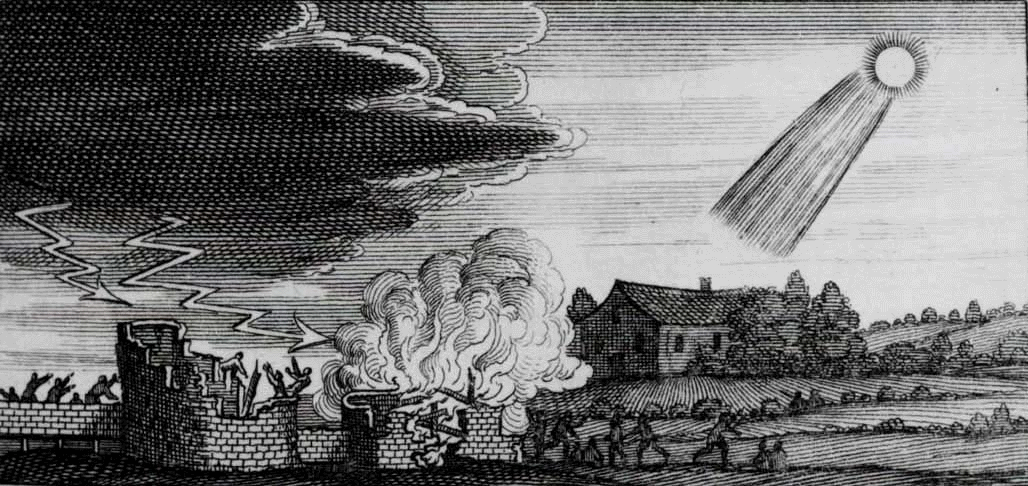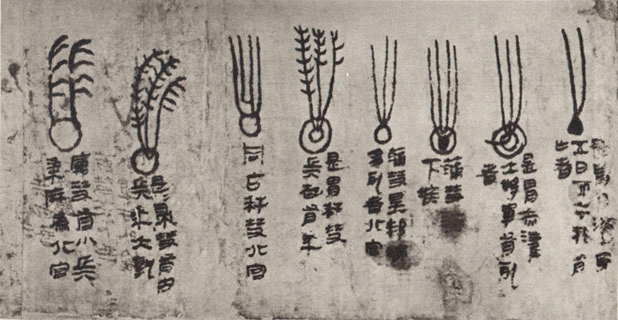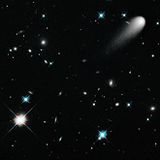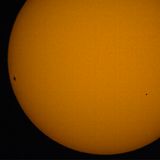
If comet ISON becomes visible to the naked eye as it approaches the Sun, try imagining yourself watching it two thousand years ago.
At first glance you wouldn't have been able to tell that the new object was moving at all against the background of stars. Probably bewildering was the comet's tail - which seemed to flow away from an object that was just hanging in the sky. If the comet wasn't moving, why did it have such a magnificent train?

Woodcut showing the destructive influence of a 4th century comet, by Stanilaus Lubienietski's Theatrum Cometicum (Amsterdam, 1668.) Credit: NASA/JPL
There was no shortage of opinions about what the tail might mean. In the second century A.D., the Greek astronomer Ptolemy reported that comets contained everything needed to make a detailed prediction of earthly events: "They show, through the parts of the Zodiac in which their heads appear and through the directions in which their tails point, the regions upon which misfortunes impend. Through the formations of their heads they indicate the kind of the event and the class upon which the misfortune will take effect; through the time which they last, the duration of the events; and through their position relative to the Sun likewise their beginning."
Writing two thousand years ago, the Roman astrologer Marcus Manilius offered the typical opinion that comets were signs from Heaven of impending disaster. Included in his list of tribulations were failed crops, plague, wars, insurrection, and even family feuds. Anything could be blamed on comets!
Perhaps it was natural for soothsayers to take advantage of such a conspicuous opportunity to practice their art. At any rate, the art of cometary prophecy flourished, encouraged by the Church, which was quick to interpret comets as signs from God. You could read into the mysterious flare in the sky whatever your imagination suggested.
Most celestial bodies travel across the sky at intervals so regular that the motions of constellations could be mapped and predicted. But the movements of comets have always seemed erratic and unpredictable. This led people in many cultures to believe that the gods dictated the motions of comets and were sending them as a message. What were the gods trying to say?
To some cultures the tail of a comet gave it the appearance of a woman's head, with long hair flowing behind her. This symbol of mourning was taken to mean that the gods that had sent the comet were displeased. Others thought that a comet looked like a fiery sword in the night sky, a traditional sign of war and death. Such a message from the gods must mean that their wrath would soon be visited on the people of the land.
Unlike their Western counterparts, Chinese astronomers kept extensive records on the appearances, paths, and disappearances of hundreds of comets. Catalogs have been found dating back to the Han Dynasty, and they describe comets as "long-tailed pheasant stars" or "broom stars" and associate the different forms of comets with different disasters. These detailed records allowed later astronomers to determine the true nature of comets.

Silk Atlas of Comets from the Hunan Provincial Museum. Credit: International Dunhuang Project, from the Album of Relics of Ancient Chinese Astronomy, Zhongguo Gudai Tianwen Wenwu Tuji, CASS (Chinese Academy of Social Sciences, Institute of Archaeology), 1980. Beijing
Beliefs about comets were influenced for more than two thousand years by the Greek philosopher Aristotle, who declared in the 4th century B.C. that comets were strictly atmospheric phenomena. In Aristotle's cosmology, Earth was stationary at the center of the universe, and all celestial bodies - the Sun, Moon, planets, and stars - revolved around Earth on spheres of pure crystal. So, any temporary aberration such as a comet had to be in the atmosphere below the crystal spheres.
According to Aristotle, comets were produced by gases that rose into the upper atmosphere where they caught fire, ignited by sparks generated by the motion of the heavenly spheres. If the gases burned quickly, they produced the sudden flash of a shooting star. If they burned slowly, the result was a comet.
Of all the ancient writers on comets, the one who came closest to the truth was Lucius Seneca, a Roman of the first century A.D. Seneca argued that comets were celestial bodies moving in orbits like the planets, and that therefore they might eventually reappear: "Men will someday be able to demonstrate in what regions comets have their paths, why they move so far from the planets, and what is their size and constitution," he wrote.
But in his own time, Seneca was ignored as a threat to the soothsayers' thriving business. Seventeen centuries passed before the first part of his prediction came true - that men would someday be able to determine comets' paths - but the second part, concerning the size and composition of comets, is only now being fulfilled.
Why do you think comets inspired such dread in our ancestors, while today they are enthusiastically anticipated? Leave a comment!
Article thumbnail: A view of Augsburg, Germany with the comets of 1680, 1682, and 1683. Credit: NASA/JPL
Hal Kibbey is a science writer and an amateur astronomer. He majored in physics at Cornell University and in the history of science at Indiana University in Bloomington, where he particularly studied physics at the time of Isaac Newton. Since 1980 he has written a monthly column describing what can currently be seen in the night sky. He writes an Early Astronomy column for Orion Telescopes & Binoculars.



















